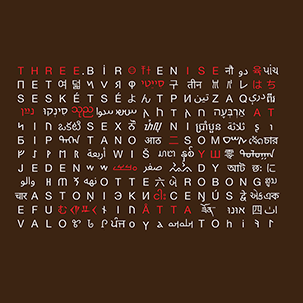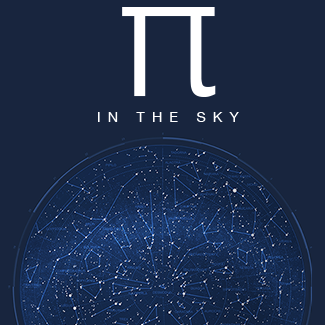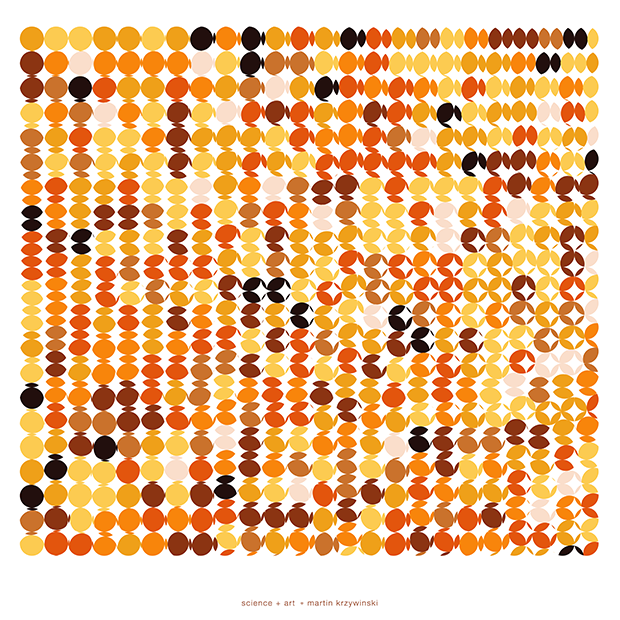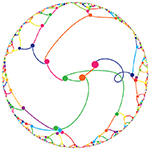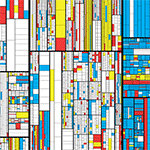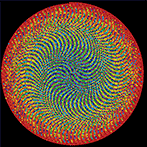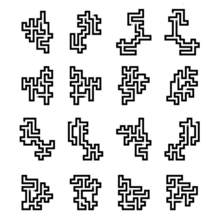`\pi` Day 2019 Art Posters - Digits, internationally.
On March 14th celebrate `\pi` Day. Hug `\pi`—find a way to do it.
For those who favour `\tau=2\pi` will have to postpone celebrations until July 26th. That's what you get for thinking that `\pi` is wrong. I sympathize with this position and have `\tau` day art too!
If you're not into details, you may opt to party on July 22nd, which is `\pi` approximation day (`\pi` ≈ 22/7). It's 20% more accurate that the official `\pi` day!
Finally, if you believe that `\pi = 3`, you should read why `\pi` is not equal to 3.
How many ages hence
Shall this our lofty scene be acted over
In states unborn and accents yet unknown!
—Willian Shakespeare (Julius Caesar, Act III, Scene 1)
Welcome to this year's celebration of `\pi` and mathematics.
The theme this year is typographical and pure—in contrast to last year's extremely elaborate computational art. This year is also the first time I have made a special kids' edition!
This year's poem is by Viorica Hrincu and it is about complications.
This year's `\pi` day song is Tshinanu by Kashtin.
If you enjoy art based on type, explore my other typographical works.
The posters were generated automatically with some optimization for avoiding word wrapping, balancing different alphabets across the page, word lengths, specific digit terminations (e.g. international kids poster ends in a 3) and so on.
download multi-language number word list
You can download my list of numbers 0 to 9 in various languages. The list has some in-line annotations used in this process.
Download number word list
v0.1 12 Mar 2019
Below are the digit and word lists for each poster. The format is
digit_index[digit](language)word
Kids, English (127 digits)
0[3]THREE 1[1]ONE 2[4]FOUR 3[1]ONE 4[5]FIVE 5[9]NINE 6[2]TWO 7[6]SIX 8[5]FIVE 9[3]THREE 10[5]FIVE 11[8]EIGHT 12[9]NINE 13[7]SEVEN 14[9]NINE 15[3]THREE 16[2]TWO 17[3]THREE 18[8]EIGHT 19[4]FOUR 20[6]SIX 21[2]TWO 22[6]SIX 23[4]FOUR 24[3]THREE 25[3]THREE 26[8]EIGHT 27[3]THREE 28[2]TWO 29[7]SEVEN 30[9]NINE 31[5]FIVE 32[0]ZERO 33[2]TWO 34[8]EIGHT 35[8]EIGHT 36[4]FOUR 37[1]ONE 38[9]NINE 39[7]SEVEN 40[1]ONE 41[6]SIX 42[9]NINE 43[3]THREE 44[9]NINE 45[9]NINE 46[3]THREE 47[7]SEVEN 48[5]FIVE 49[1]ONE 50[0]ZERO 51[5]FIVE 52[8]EIGHT 53[2]TWO 54[0]ZERO 55[9]NINE 56[7]SEVEN 57[4]FOUR 58[9]NINE 59[4]FOUR 60[4]FOUR 61[5]FIVE 62[9]NINE 63[2]TWO 64[3]THREE 65[0]ZERO 66[7]SEVEN 67[8]EIGHT 68[1]ONE 69[6]SIX 70[4]FOUR 71[0]ZERO 72[6]SIX 73[2]TWO 74[8]EIGHT 75[6]SIX 76[2]TWO 77[0]ZERO 78[8]EIGHT 79[9]NINE 80[9]NINE 81[8]EIGHT 82[6]SIX 83[2]TWO 84[8]EIGHT 85[0]ZERO 86[3]THREE 87[4]FOUR 88[8]EIGHT 89[2]TWO 90[5]FIVE 91[3]THREE 92[4]FOUR 93[2]TWO 94[1]ONE 95[1]ONE 96[7]SEVEN 97[0]ZERO 98[6]SIX 99[7]SEVEN 100[9]NINE 101[8]EIGHT 102[2]TWO 103[1]ONE 104[4]FOUR 105[8]EIGHT 106[0]ZERO 107[8]EIGHT 108[6]SIX 109[5]FIVE 110[1]ONE 111[3]THREE 112[2]TWO 113[8]EIGHT 114[2]TWO 115[3]THREE 116[0]ZERO 117[6]SIX 118[6]SIX 119[4]FOUR 120[7]SEVEN 121[0]ZERO 122[9]NINE 123[3]THREE 124[8]EIGHT 125[4]FOUR 126[4]FOUR
Kids, International (116 digits, 64 languages )
0[3](English)THREE, 1[1](Samoan)TASI, 2[4](Zenaga)AKOZ, 3[1](Sesotho)NNGWE, 4[5](Zenaga)SHAMMUSH, 5[9](Croatian)DEVET, 6[2](Latvian)DIVI, 7[6](Maltese)SITTA, 8[5](Solresol)RELALA, 9[3](Lithuanian)TRYS, 10[5](Catalan)CINC, 11[8](Irish)OCHT, 12[9](French)NEUF, 13[7](Portuguese)SETE, 14[9](Dutch)NEGEN, 15[3](French)TROIS, 16[2](Cebuano)DUHA, 17[3](Gongduk)TAWA, 18[8](English)EIGHT, 19[4](Frisian)FJOUWER, 20[6](Gongduk)KUPA, 21[2](Afrikaans)TWEE, 22[6](Frisian)SEIS, 23[4](Malagasy)EFATRA, 24[3](Finnish)KOLME, 25[3](Estonian)KOLM, 26[8](Croatian)OSAM, 27[3](Corsican)QUATTRU, 28[2](Khasi)AR, 29[7](Nao)TESSEN, 30[9](Hausa)TARA, 31[5](Zulu)KUHLANU, 32[0](Xhosa)UNOTHI, 33[2](Puyuma)ZUWA, 34[8](Shona)SERE, 35[8](Ladan)NIB, 36[4](Somali)AFAR, 37[1](Esperanto)UNU, 38[9](Welsh)NAW, 39[7](Latin)SEPTEM, 40[1](Spanish)UNO, 41[6](French)SIX, 42[9](Lithuanian)DEVYNI, 43[3](Haitian_creole)TWA, 44[9](German)NEUN, 45[9](Zenaga)TUZA, 46[3](Catalan)TRES, 47[7](Cebuano)PITO, 48[5](Maori)RIMA, 49[1](Maori)TAHI, 50[0](Galician)CERO, 51[5](Icelandic)FIMM, 52[8](Finnish)KAHDEKSAN, 53[2](Zenaga)SHINAN, 54[0](Tagalog)SERO, 55[9](English)NINE, 56[7](Malagasy)FITO, 57[4](Indonesian)EMPAT, 58[9](Turkish)DOKUZ, 59[4](Lithuanian)KETURI, 60[4](Swahili)NNE, 61[5](Latvian)PIECI, 62[9](Dothraki)QAZAT, 63[2](Swahili)MBILI, 64[3](Cebuano)TULO, 65[0](Azerbaijani)SIFIR, 66[7](Dothraki)FEKH, 67[8](Slovenian)OSEM, 68[1](Tetun)IDA, 69[6](Hawaiian)EONO, 70[4](Tetun)HAT, 71[0](Corsican)ZERU, 72[6](Xhosa)ZINTANDATHU, 73[2](Maori)RUA, 74[8](Nao)ZYAD, 75[6](Dutch)ZES, 76[2](Hausa)BIYU, 77[0](Swedish)NOLL, 78[8](Danish)OTTE, 79[9](Scots_gaelic)NAOI, 80[9](Spanish)NUEVE, 81[8](Ro)ZAQ, 82[6](Ro)ZAL, 83[2](Ladan)SHIN, 84[8](Esperanto)OK, 85[0](Hausa)SIFILI, 86[3](Polish)TRZY, 87[4](Basque)LAU, 88[8](Basque)ZORTZI, 89[2](Haitian_creole)DE, 90[5](Xhosa)ZINTLANU, 91[3](Welsh)TRI, 92[4](Afrikaans)VIER, 93[2](Albanian)DY, 94[1](Frisian)IEN, 95[1](Tenerife)BEN, 96[7](Norwegian)SJU, 97[0](Dothraki)SOM, 98[6](Solon)NINGUN, 99[7](Slovak)SEDEM, 100[9](Tetun)SIA, 101[8](Welsh)WYTH, 102[2](Yoruba)MEJI, 103[1](Slovak)JEDEN, 104[4](Danish)FIRE, 105[8](Luxembourgish)AACHT, 106[0](German)NULL, 107[8](Maltese)TMIENJA, 108[6](Huastec_mayan)ACAC, 109[5](Welsh)PUMP, 110[1](Solon)YMUN, 111[3](Danish)TRE, 112[2](Dothraki)AKAT, 113[8](Scots_gaelic)OCHD, 114[2](Italian)DUE, 115[3](English)THREE
words, international (223 digits, 102 languages)
Some characters may not display on your screen if you do not have the supporting font. The lists below include the row of the word
digit_index:row[digit](language)word
0:0[3](English)THREE 1:0[1](Turkish)BİR 2:0[4](Greek_old)𐀤𐀵𐀫 3:0[1](Danish)EN 4:0[5](Igbo)ISE 5:0[9](Hindi)नौ 6:0[2](Urdu)دو 7:0[6](Koreansino)육 8:0[5](Gujarati)પાંચ 9:1[5](Bulgarian)ПЕТ 10:1[8](Korean)여덟 11:1[9](Etruscan)𐌍𐌖𐌓𐌘 12:1[7](Ladino)סִייֵּטִי 13:1[9](Koreansino)구 14:1[3](Hindi)तीन 15:1[2](Greek_old)𐀉𐀺 16:1[3](Ainu)レ 17:1[8](Japanese_sino)はち 18:2[6](Afrikaans)SES 19:2[2](Hungarian)KÉT 20:2[6](Irish)SÉ 21:2[4](Japanese_sino)よん 22:2[3](Macedonian)ТРИ 23:2[3](Urdu)تین 24:2[8](Ro)ZAQ 25:2[3](Pashto)درې 26:2[2](Khmer)ពីរ 27:3[9](Yiddish)נײַן 28:3[5](Ladino)סִינְקוּ 29:3[0](Myanmar)သုည 30:3[2](Malay)دوا 31:3[8](Avestan)𐬀𐬱𐬙𐬀 32:3[8](Gothic)𐌰𐌷𐍄𐌰𐌿 33:3[4](Biblical_arameic)אַרְבְּעָה 34:3[1](Dothraki)AT 35:4[7](Norse)ᛋᛁᚢ 36:4[1](Telugu)ఒకటి 37:4[6](Swedish)SEX 38:4[9](Punjabi)ਨੌ 39:4[3](Sundanese)ᮒᮤᮜᮥ 40:4[9](Norwegian)NI 41:4[9](Khmer)ប្រាំបួន 42:4[3](Arabic)ثلاثة 43:4[7](Yi)ʂɿ 44:5[1](Kazakh)БІР 45:5[0](Mongolianclassical)ᠲᠡᠭᠡᠨ 46:5[5](Swahili)TANO 47:5[8](Hindi)आठ 48:5[2](Chinese)二 49:5[0](Dothraki)SOM 50:5[9](Samaritan)ࠕࠔࠏ 51:5[7](Lao)ເຈັດ 52:5[4](Bengali)চার 53:6[4](Old_english)ᚠᛇᚹᛖᚱ 54:6[4](Arabic)أربعة 55:6[5](Wyandot)WIŠ 56:6[9](Javanese)ꦱꦔ 57:6[2](Myanmar)နှစ် 58:6[3](Kazakh)ҮШ 59:6[0](Chinese)零 60:6[7](Mongolianclassical)ᠳᠣᠯᠤᠭᠠᠨ 61:7[1](Slovak)JEDEN 62:7[6](Phoenician)𐤔𐤔 63:7[4](Mandaic)ࡀࡓࡁࡉ 64:7[0](Persian)صفر 65:7[6](Buginese)ᨕᨛᨊᨛ 66:7[2](Albanian)DY 67:7[8](Bengali)আট 68:7[6](Hindi)छः 69:7[2](Japanese_sino)に 70:8[8](Banjar)والو 71:8[9](Amharic)ዘጠኝ 72:8[9](Pashto)نهه 73:8[8](Danish)OTTE 74:8[6](Chinese)六 75:8[2](Gujarati)બે 76:8[8](Sesotho)ROBONG 77:8[0](Lao)ສູນ 78:9[4](Hindi)चार 79:9[8](Latvian)ASTOŅI 80:9[2](Kyrgyz)ЭКИ 81:9[5](Myanmar)ငါး 82:9[3](Tajik)СЕ 83:9[4](Klallam)ŊÚS 84:9[2](Sanskrit)द्वे 85:9[1](Gujarati)એક 86:9[1](Bengali)এক 87:10[0](Igbo)EFU 88:10[6](Yonaguni)む 89:10[7](Ugaritic)𐎌𐎁𐎓 90:10[9](Norse)ᚾᛁᚢ 91:10[8](Swedish)ÅTTA 92:10[2](Bumthang)ཟོན་་ 93:10[1](Ladino)אוּנוּ 94:10[4](Chinese)四 95:10[8](Sindhi)اٺ 96:11[8](Malagasy)VALO 97:11[6](Cherokee)ᏑᏓᎵ 98:11[5](Punjabi)ਪੰਜ 99:11[1](Coptic)ⲟⲩⲁ 100:11[3](Mandaic)ࡕࡋࡀࡕࡀ 101:11[2](Danish)TO 102:11[8](Yi)hi 103:11[2](Old_turkic)𐰚𐰃 104:12[0](Yiddish)נול 105:12[6](Malay)انم 106:12[6](Ugaritic)𐎘𐎘 107:12[4](Syriac)ܐܰܪܒܥܳܐ 108:12[7](Klallam)C̓ÚʔKʷS 109:12[0](Sinhala)ශුන්යය 110:12[9](Banjar)ساڠ 111:12[3](Sylheti)ꠔꠤꠘ 112:12[8](Pashto)اته 113:13[4](Yonaguni)どぅ 114:13[6](Yi)fu 115:13[0](Catalan)ZERO 116:13[9](Esperanto)NAŬ 117:13[5](Welsh)PUMP 118:13[5](Malay)ليم 119:13[0](Amharic)ዜሮ 120:13[5](Khmer)ប្រាំ 121:14[2](Punjabi)ਦੋ 122:14[2](Frisian)TWA 123:14[3](Sindhi)ٽي 124:14[1](Syriac)ܚܰܕ 125:14[7](Azerbaijani)YEDDİ 126:14[2](Inuktitut)ᒪᕐᕉᒃ 127:14[5](Sylheti)ꠙꠣꠌ 128:14[3](Latvian)TRĪS 129:15[9](Coptic)ⲫⲓⲧ 130:15[4](Tetun)HAT 131:15[0](Punjabi)ਿਸਫਰ 132:15[8](Amharic)ስምት 133:15[1](Albanian)NJË 134:15[2](Biblical_arameic)תְּרֵין 135:15[8](Sylheti)ꠀꠑ 136:15[4](Sindhi)چار 137:15[8](Myanmar)ရှစ် 138:16[1](Buginese)ᨔᨙᨉᨗ 139:16[1](Lao)ນຶ່ງ 140:16[7](Sinhala)හත 141:16[4](Gaulish)𐌐𐌄𐌕𐌏𐌓 142:16[5](Sanskrit)पञ्च 143:16[0](Javanese)ꦤꦺꦴꦭ꧀ 144:16[2](Ainu)トゥ 145:16[8](Esperanto)OK 146:16[4](Thai)สี่ 147:17[0](Slovenian)NIČ 148:17[2](Avestan)𐬛𐬬𐬀 149:17[7](Hindi)सात 150:17[0](Samoan)SELO 151:17[1](Greek_old)𐀁𐀕 152:17[9](Mongolianclassical)ᠢᠰᠦᠨ 153:17[3](Malayalam)മുന്ന് 154:17[8](Punjabi)ਅੱਠ 155:17[5](Koreansino)오 156:18[1](Spanish)UNO 157:18[1](Samaritan)ࠇࠠࠃࠠࠄ 158:18[0](Ro)ZAX 159:18[5](Ainu)アシㇰネ 160:18[5](Telugu)ఐదు 161:18[5](Bumthang)ཡ་ང་་ 162:18[9](Yi)ɡu 163:18[6](Gujarati)છ 164:19[4](Sundanese)ᮇᮕᮒ᮪ 165:19[6](Romanian)ŞASE 166:19[2](Hebrew)שתיים 167:19[2](Kazakh)ЕКІ 168:19[9](Phoenician)𐤕𐤔𐤏 169:19[4](Yiddish)פֿיר 170:19[8](Chinese)八 171:19[9](Sindhi)نو 172:20[4](Phoenician)𐤀𐤓𐤁 173:20[9](Balinese)ᬲᬶᬬ 174:20[3](Persian)سه 175:20[0](Galician)CERO 176:20[3](Klallam)ꞭÍXʷ 177:20[8](Ladan)NIB 178:20[1](Kannada)ಒಂದು 179:20[9](Sanskrit)नव 180:21[4](Lao)ສີ່ 181:21[4](Xhosa)ZINE 182:21[2](Proto_germanic)ᛏᚹᚨ 183:21[8](Koreansino)팔 184:21[8](Sinhala)අට 185:21[1](Old_english)ᚪᚾ 186:21[0](Malagasy)AOTRA 187:21[9](Persian)نه 188:22[5](Norwegian)FEM 189:22[6](Hopi)NAVAY 190:22[6](Syriac)ܐܶܫܬܳܐ 191:22[5](Czech)PĚT 192:22[9](Gujarati)નવ 193:22[3](Kannada)ಮೂರು 194:22[3](Khmer)បី 195:22[4](Samoan)FĀ 196:23[6](Sanskrit)षष् 197:23[1](Georgian)ერთი 198:23[2](Mandaic)ࡕࡓࡉࡍ 199:23[8](Georgian_old)ႰႥႠჂ 200:23[4](Swahili)NNE 201:23[7](Banjar)ڤيتو 202:23[5](Chinese)五 203:23[6](Armenian)վեց 204:24[8](Mongolianclassical)ᠨᠠᠢᠮᠠᠨ 205:24[2](Sindhi)ٻه 206:24[3](Thompson)KEʔŁÉS 207:24[3](Ugaritic)𐎘𐎍𐎘 208:24[7](Slavonic)СЕДМЬ 209:24[8](Sanskrit)अष्ट 210:24[6](Urdu)چھ 211:24[7](Gujarati)સાત 212:25[3](Biblical_arameic)תְּלָתָה 213:25[1](Phoenician)𐤀𐤇𐤃 214:25[6](Balinese)ᬦᭂᬦᭂᬫ᭄ 215:25[5](Yiddish)פֿינף 216:25[2](Malayalam)രണ്ട് 217:25[7](Sindhi)ست 218:25[1](Cia-cia)루아 219:25[2](Arabic)اثنان 220:25[0](Ladino)זִרוֹ 221:26[9](Greekkoine)ἐννέα 222:26[9](Iglulingmiutut)ᖁᓕᖃᙱᑐᐃᓐᓇᖅᑐᑦ
single glyphs, international (351 digits, 54 alphabets)
Below "Numbers" for the language indicates the Roman alphabet digits 0...9.
0:0[3](Numbers)3 1:0[1](Odia)୧ 2:0[4](Sumerian)𒐼 3:0[1](Ethiopic)፩ 4:0[5](Limbu)᥋ 5:0[9](Rumi)𐹨 6:0[2](Koreansino)이 7:0[6](Gujarati)છ 8:0[5](Klingon)5 9:0[3](Sundanese)᮳ 10:0[5](Lepcha)᱅ 11:0[8](Burmese)၈ 12:0[9](Sinhalaarchaic)𑇩 13:0[7](Malayalam)൭ 14:0[9](Osmanya)𐒩 15:0[3](Yi)ꌕ 16:1[3](Numbers)3 17:1[8](Cham)꩘ 18:1[4](Oriya)୪ 19:1[6](Yi)ꃘ 20:1[2](Kayahli)꤂ 21:1[6](Tibetan)༦ 22:1[4](Sanskrit)४ 23:1[3](Tamil)௩ 24:1[3](Lepcha)᱃ 25:1[8](Burmese)၈ 26:1[3](Telugu)౩ 27:1[2](Sinhala)෨ 28:1[7](Malayalam)൭ 29:1[9](Arabic)٩ 30:1[5](Nko)߅ 31:1[0](Osmanya)𐒠 32:2[8](Kannada)೮ 33:2[8](Sinhalaarchaic)𑇨 34:2[4](Arabic)٤ 35:2[1](Balinese)᭑ 36:2[9](Chinese)九 37:2[7](Yi)ꏃ 38:2[1](Lao)໑ 39:2[6](Nko)߆ 40:2[9](Shan)႙ 41:2[3](Copticepact)𐋣 42:2[9](Brahmi)𑁯 43:2[9](Sanskrit)९ 44:2[3](Gurmukhi)੩ 45:2[7](Bengali)৭ 46:2[5](Telugu)౫ 47:2[1](Burmese)၁ 48:3[5](Sumerian)𒐊 49:3[8](Yi)ꉆ 50:3[2](Kharoshthi)𐩁 51:3[0](Lepcha)᱀ 52:3[9](Bengali)৯ 53:3[7](Koreansino)칠 54:3[4](Limbu)᥊ 55:3[9](Balinese)᭙ 56:3[4](Kayahli)꤄ 57:3[4](Lao)໔ 58:3[5](Kannada)೫ 59:3[9](Chinese)九 60:3[2](Copticepact)𐋢 61:3[3](Sinhalaarchaic)𑇣 62:3[0](Tibetan)༠ 63:3[7](Arabic)٧ 64:4[1](Kharoshthi)𐩀 65:4[6](Hebrew)ו 66:4[4](Osmanya)𐒤 67:4[0](Sundanese)᮰ 68:4[6](Khmer)៦ 69:4[2](Brahmi)𑁨 70:4[8](Oriya)୮ 71:4[6](Javanese)꧖ 72:4[2](Klingon)2 73:4[0](Lepcha)᱀ 74:4[8](Burmese)၈ 75:4[9](Sanskrit)९ 76:4[9](Olchiki)᱙ 77:4[8](Arabic)٨ 78:4[6](Yonaguni)む 79:4[2](Punjabi)੨ 80:5[0](Burmese)၀ 81:5[3](Ainu)レ 82:5[4](Odia)୪ 83:5[8](Lao)໘ 84:5[2](Yi)ꑍ 85:5[5](Sundanese)᮵ 86:5[3](Osmanya)𐒣 87:5[4](Limbu)᥊ 88:5[2](Sinhala)෨ 89:5[1](Copticepact)𐋡 90:5[1](Sumerian)𒁹 91:5[7](Khmer)៧ 92:5[0](Tibetan)༠ 93:5[6](Thai)๖ 94:5[7](Koreansino)칠 95:5[9](Japanese_sino)く 96:6[2](Rumi)𐹡 97:6[1](Nko)߁ 98:6[4](Javanese)꧔ 99:6[8](Telugu)౮ 100:6[0](Sinhala)෦ 101:6[8](Ethiopic)፰ 102:6[6](Thai)๖ 103:6[5](Roman)V 104:6[1](Koreansino)일 105:6[3](Copticepact)𐋣 106:6[2](Limbu)᥈ 107:6[8](Yonaguni)だ 108:6[2](Kannada)೨ 109:6[3](Mongolian)᠓ 110:6[0](Vai)꘠ 111:6[6](Punjabi)੬ 112:7[4](Klingon)4 113:7[7](Nko)߇ 114:7[0](Kayahli)꤀ 115:7[9](Brahmi)𑁯 116:7[3](Chakma)𑄹 117:7[8](Yi)ꉆ 118:7[4](Sundanese)᮴ 119:7[4](Osmanya)𐒤 120:7[6](Sinhala)෬ 121:7[0](Arabic)٠ 122:7[9](Saurashtra)꣙ 123:7[5](Meeteimayek)꯵ 124:7[5](Adlam)𞥕 125:7[0](Koreansino)공 126:7[5](Numbers)5 127:7[8](Gurmukhi)੮ 128:8[2](Tibetan)༢ 129:8[3](Vai)꘣ 130:8[1](Sinhala)෧ 131:8[7](Lepcha)᱇ 132:8[2](Gujaranti)૨ 133:8[5](Chakma)𑄻 134:8[3](Brahmi)𑁩 135:8[5](Hebrew)ה 136:8[9](Odia)୯ 137:8[4](Copticepact)𐋤 138:8[0](Kayahli)꤀ 139:8[8](Sumerian)𒑄 140:8[1](Sanskrit)१ 141:8[2](Rumi)𐹡 142:8[8](Sundanese)᮸ 143:8[4](Telugu)౪ 144:9[1](Odia)୧ 145:9[1](Ethiopic)፩ 146:9[1](Chinese)一 147:9[7](Gujaranti)૭ 148:9[4](Koreansino)사 149:9[5](Khmer)៥ 150:9[0](Kayahli)꤀ 151:9[2](Osmanya)𐒢 152:9[8](Sinhala)෮ 153:9[4](Olchiki)᱔ 154:9[1](Kharoshthi)𐩀 155:9[0](Lepcha)᱀ 156:9[2](Kannada)೨ 157:9[7](Telugu)౭ 158:9[0](Numbers)0 159:9[1](Bengali)১ 160:10[3](Sinhalaarchaic)𑇣 161:10[8](Telugu)౮ 162:10[5](Meeteimayek)꯵ 163:10[2](Sumerian)𒈫 164:10[1](Arabic)١ 165:10[1](Thai)๑ 166:10[0](Shan)႐ 167:10[5](Hebrew)ה 168:10[5](Bengali)৫ 169:10[5](Malayalam)൫ 170:10[9](Brahmi)𑁯 171:10[6](Oriya)୬ 172:10[4](Burmese)၄ 173:10[4](Kharoshthi)𐩃 174:10[6](Balinese)᭖ 175:10[2](Japanese_sino)に 176:11[9](Tamil)௯ 177:11[4](Telugu)౪ 178:11[8](Punjabi)੮ 179:11[9](Osmanya)𐒩 180:11[5](Khmer)៥ 181:11[4](Chinese)四 182:11[9](Arabic)٩ 183:11[3](Kayahli)꤃ 184:11[0](Sinhala)෦ 185:11[3](Nko)߃ 186:11[8](Copticepact)𐋨 187:11[1](Lao)໑ 188:11[9](Thai)๙ 189:11[6](Tibetan)༦ 190:11[4](Sundanese)᮴ 191:11[4](Odia)୪ 192:12[8](Lao)໘ 193:12[8](Javanese)꧘ 194:12[1](Roman)I 195:12[0](Burmese)၀ 196:12[9](Bengali)৯ 197:12[7](Lepcha)᱇ 198:12[5](Copticepact)𐋥 199:12[6](Gujaranti)૬ 200:12[6](Tibetan)༦ 201:12[5](Sundanese)᮵ 202:12[9](Klingon)9 203:12[3](Sanskrit)३ 204:12[3](Yi)ꌕ 205:12[4](Vai)꘤ 206:12[4](Korean)넷 207:12[6](Tamil)௬ 208:13[2](Khmer)២ 209:13[8](Meeteimayek)꯸ 210:13[4](Kannada)೪ 211:13[7](Brahmi)𑁭 212:13[5](Tibetan)༥ 213:13[6](Balinese)᭖ 214:13[4](Lepcha)᱄ 215:13[8](Saurashtra)꣘ 216:13[2](Burmese)၂ 217:13[3](Mongolian)᠓ 218:13[3](Rumi)𐹢 219:13[7](Limbu)᥍ 220:13[8](Arabic)٨ 221:13[6](Chinese)六 222:13[7](Numbers)7 223:13[8](Osmanya)𐒨 224:14[1](Olchiki)᱑ 225:14[6](Sundanese)᮶ 226:14[5](Yi)ꉬ 227:14[2](Koreansino)이 228:14[7](Vai)꘧ 229:14[1](Balinese)᭑ 230:14[2](Hebrew)ב 231:14[0](Brahmi)𑁦 232:14[1](Oriya)୧ 233:14[9](Gurmukhi)੯ 234:14[0](Arabic)٠ 235:14[9](Saurashtra)꣙ 236:14[1](Odia)୧ 237:14[4](Meeteimayek)꯴ 238:14[5](Telugu)౫ 239:14[6](Cham)꩖ 240:15[8](Sinhala)෮ 241:15[5](Limbu)᥋ 242:15[6](Thai)๖ 243:15[6](Copticepact)𐋦 244:15[9](Tamil)௯ 245:15[2](Shan)႒ 246:15[3](Telugu)౩ 247:15[4](Vai)꘤ 248:15[6](Odia)୬ 249:15[0](Osmanya)𐒠 250:15[3](Klingon)3 251:15[4](Hebrew)ד 252:15[8](Javanese)꧘ 253:15[6](Oriya)୬ 254:15[1](Adlam)𞥑 255:15[0](Tibetan)༠ 256:16[5](Arabic)٥ 257:16[4](Gujaranti)૪ 258:16[3](Shan)႓ 259:16[2](Japanese_sino)に 260:16[6](Odia)୬ 261:16[6](Javanese)꧖ 262:16[4](Osmanya)𐒤 263:16[8](Sundanese)᮸ 264:16[2](Hebrew)ב 265:16[1](Kharoshthi)𐩀 266:16[3](Nko)߃ 267:16[3](Ainu)レ 268:16[9](Kayahli)꤉ 269:16[3](Chakma)𑄹 270:16[6](Kannada)೬ 271:16[0](Klingon)0 272:17[2](Klingon)2 273:17[6](Tamil)௬ 274:17[0](Numbers)0 275:17[2](Kharoshthi)𐩁 276:17[4](Lepcha)᱄ 277:17[9](Sundanese)᮹ 278:17[1](Mongolian)᠑ 279:17[4](Meeteimayek)꯴ 280:17[1](Khmer)១ 281:17[2](Kannada)೨ 282:17[7](Bengali)৭ 283:17[3](Sumerian)𒐈 284:17[7](Saurashtra)꣗ 285:17[2](Copticepact)𐋢 286:17[4](Hebrew)ד 287:17[5](Koreansino)오 288:18[7](Klingon)7 289:18[0](Arabic)٠ 290:18[0](Osmanya)𐒠 291:18[6](Lepcha)᱆ 292:18[6](Malayalam)൬ 293:18[0](Sinhala)෦ 294:18[6](Shan)႖ 295:18[3](Vai)꘣ 296:18[1](Bengali)১ 297:18[5](Yi)ꉬ 298:18[5](Khmer)៥ 299:18[8](Punjabi)੮ 300:18[8](Mongolian)᠘ 301:18[1](Thai)๑ 302:18[7](Koreansino)칠 303:18[4](Cham)꩔ 304:19[8](Meeteimayek)꯸ 305:19[1](Gurmukhi)੧ 306:19[5](Malayalam)൫ 307:19[2](Kayahli)꤂ 308:19[0](Numbers)0 309:19[9](Limbu)᥏ 310:19[2](Javanese)꧒ 311:19[0](Osmanya)𐒠 312:19[9](Tamil)௯ 313:19[6](Telugu)౬ 314:19[2](Sinhalaarchaic)𑇢 315:19[8](Punjabi)੮ 316:19[2](Sinhala)෨ 317:19[9](Koreansino)구 318:19[2](Kharoshthi)𐩁 319:19[5](Ethiopic)፭ 320:20[0](Shan)႐ 321:20[9](Nko)߉ 322:20[1](Mongolian)᠑ 323:20[7](Koreansino)칠 324:20[1](Chinese)一 325:20[5](Copticepact)𐋥 326:20[3](Kharoshthi)𐩂 327:20[6](Numbers)6 328:20[4](Meeteimayek)꯴ 329:20[3](Kayahli)꤃ 330:20[6](Yi)ꃘ 331:20[7](Olchiki)᱗ 332:20[8](Lepcha)᱈ 333:20[9](Ethiopic)፱ 334:20[2](Malayalam)൨ 335:20[5](Tibetan)༥ 336:21[0](Osmanya)𐒠 337:21[3](Lepcha)᱃ 338:21[6](Tamil)௬ 339:21[0](Shan)႐ 340:21[0](Klingon)0 341:21[1](Kannada)೧ 342:21[1](Gujaranti)૧ 343:21[3](Tibetan)༣ 344:21[3](Nko)߃ 345:21[0](Sinhala)෦ 346:21[5](Oriya)୫ 347:21[3](Yi)ꌕ 348:21[0](Brahmi)𑁦 349:21[5](Japanese_sino)ご 350:21[4](Mongolian)᠔ 351:21[8](Saurashtra)꣘
Nasa to send our human genome discs to the Moon
We'd like to say a ‘cosmic hello’: mathematics, culture, palaeontology, art and science, and ... human genomes.



Comparing classifier performance with baselines
All animals are equal, but some animals are more equal than others. —George Orwell
This month, we will illustrate the importance of establishing a baseline performance level.
Baselines are typically generated independently for each dataset using very simple models. Their role is to set the minimum level of acceptable performance and help with comparing relative improvements in performance of other models.
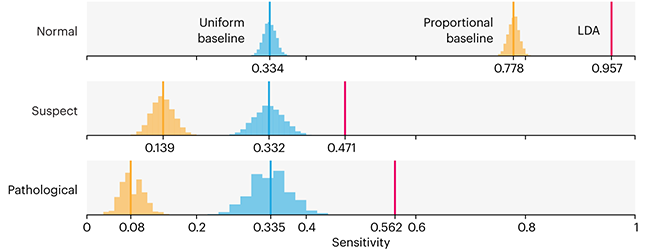
Unfortunately, baselines are often overlooked and, in the presence of a class imbalance5, must be established with care.
Megahed, F.M, Chen, Y-J., Jones-Farmer, A., Rigdon, S.E., Krzywinski, M. & Altman, N. (2024) Points of significance: Comparing classifier performance with baselines. Nat. Methods 20.
Happy 2024 π Day—
sunflowers ho!
Celebrate π Day (March 14th) and dig into the digit garden. Let's grow something.
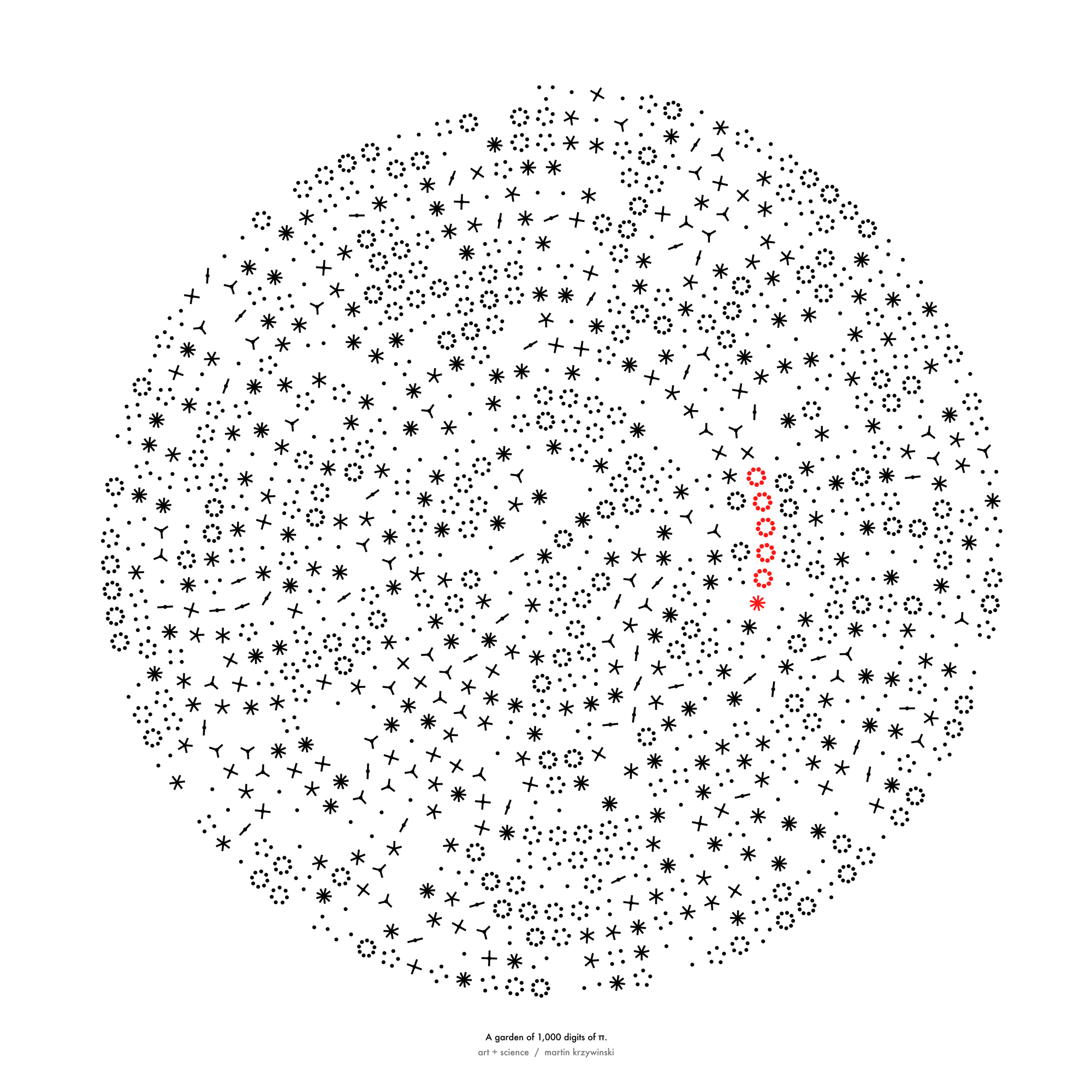
How Analyzing Cosmic Nothing Might Explain Everything
Huge empty areas of the universe called voids could help solve the greatest mysteries in the cosmos.
My graphic accompanying How Analyzing Cosmic Nothing Might Explain Everything in the January 2024 issue of Scientific American depicts the entire Universe in a two-page spread — full of nothing.
The graphic uses the latest data from SDSS 12 and is an update to my Superclusters and Voids poster.
Michael Lemonick (editor) explains on the graphic:
“Regions of relatively empty space called cosmic voids are everywhere in the universe, and scientists believe studying their size, shape and spread across the cosmos could help them understand dark matter, dark energy and other big mysteries.
To use voids in this way, astronomers must map these regions in detail—a project that is just beginning.
Shown here are voids discovered by the Sloan Digital Sky Survey (SDSS), along with a selection of 16 previously named voids. Scientists expect voids to be evenly distributed throughout space—the lack of voids in some regions on the globe simply reflects SDSS’s sky coverage.”
voids
Sofia Contarini, Alice Pisani, Nico Hamaus, Federico Marulli Lauro Moscardini & Marco Baldi (2023) Cosmological Constraints from the BOSS DR12 Void Size Function Astrophysical Journal 953:46.
Nico Hamaus, Alice Pisani, Jin-Ah Choi, Guilhem Lavaux, Benjamin D. Wandelt & Jochen Weller (2020) Journal of Cosmology and Astroparticle Physics 2020:023.
Sloan Digital Sky Survey Data Release 12
Alan MacRobert (Sky & Telescope), Paulina Rowicka/Martin Krzywinski (revisions & Microscopium)
Hoffleit & Warren Jr. (1991) The Bright Star Catalog, 5th Revised Edition (Preliminary Version).
H0 = 67.4 km/(Mpc·s), Ωm = 0.315, Ωv = 0.685. Planck collaboration Planck 2018 results. VI. Cosmological parameters (2018).
constellation figures
stars
cosmology
Error in predictor variables
It is the mark of an educated mind to rest satisfied with the degree of precision that the nature of the subject admits and not to seek exactness where only an approximation is possible. —Aristotle
In regression, the predictors are (typically) assumed to have known values that are measured without error.
Practically, however, predictors are often measured with error. This has a profound (but predictable) effect on the estimates of relationships among variables – the so-called “error in variables” problem.
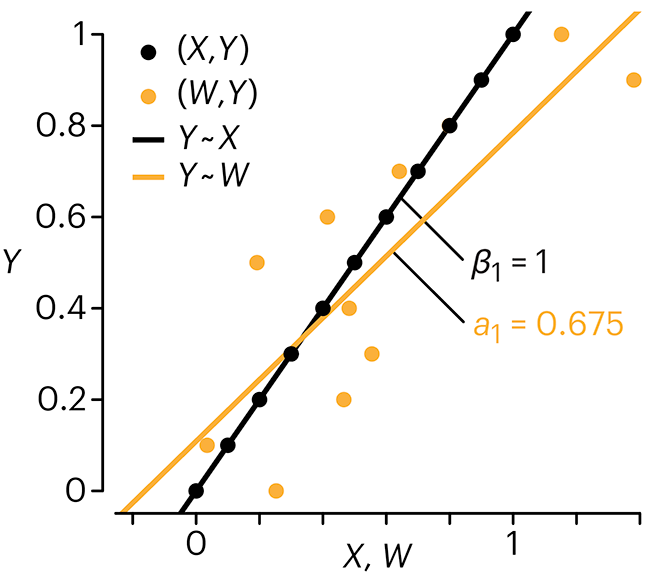
Error in measuring the predictors is often ignored. In this column, we discuss when ignoring this error is harmless and when it can lead to large bias that can leads us to miss important effects.
Altman, N. & Krzywinski, M. (2024) Points of significance: Error in predictor variables. Nat. Methods 20.
Background reading
Altman, N. & Krzywinski, M. (2015) Points of significance: Simple linear regression. Nat. Methods 12:999–1000.
Lever, J., Krzywinski, M. & Altman, N. (2016) Points of significance: Logistic regression. Nat. Methods 13:541–542 (2016).
Das, K., Krzywinski, M. & Altman, N. (2019) Points of significance: Quantile regression. Nat. Methods 16:451–452.
Convolutional neural networks
Nature uses only the longest threads to weave her patterns, so that each small piece of her fabric reveals the organization of the entire tapestry. – Richard Feynman
Following up on our Neural network primer column, this month we explore a different kind of network architecture: a convolutional network.
The convolutional network replaces the hidden layer of a fully connected network (FCN) with one or more filters (a kind of neuron that looks at the input within a narrow window).
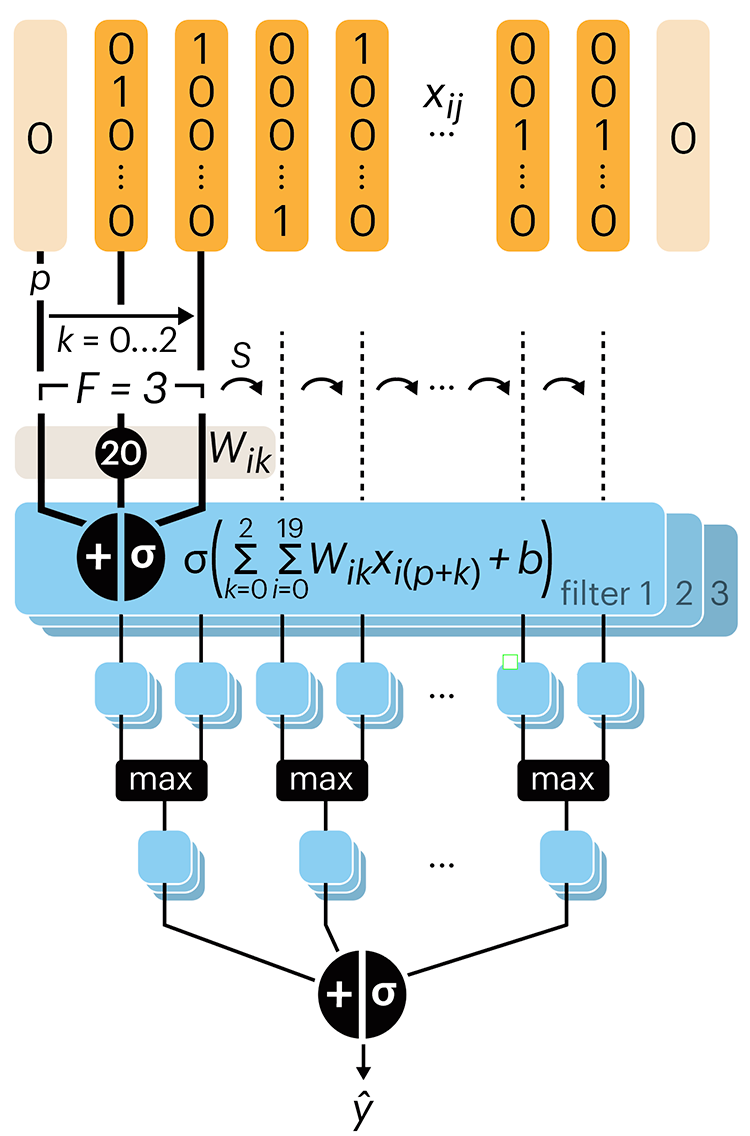
Even through convolutional networks have far fewer neurons that an FCN, they can perform substantially better for certain kinds of problems, such as sequence motif detection.
Derry, A., Krzywinski, M & Altman, N. (2023) Points of significance: Convolutional neural networks. Nature Methods 20:1269–1270.
Background reading
Derry, A., Krzywinski, M. & Altman, N. (2023) Points of significance: Neural network primer. Nature Methods 20:165–167.
Lever, J., Krzywinski, M. & Altman, N. (2016) Points of significance: Logistic regression. Nature Methods 13:541–542.



